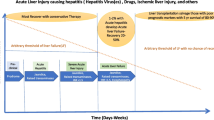Abstract
Secondary sclerosing cholangitis (SSC) is a chronic cholestatic disorder caused by mechanical, infectious, toxic, or ischemic factors. A new variant of SSC occurring after long-term treatment in intensive care units (ICU) has been recently described and characterized from the clinical point of view. The aim of this study was the histomorphological characterization of ICU-treatment-related SSC (ICU-SSC) and the definition of histological changes occurring over time based on the morphological findings. Liver biopsies of ten patients affected by ICU-SSC obtained at different time points (1.5 to 57 months) after the initial injury were analyzed. The main morphological alterations included degenerative changes of portal bile ducts, portal edema, inflammation, and fibrosis as well as biliary interface activity and bilirubinostasis. Perivenular necroses and bile infarcts were found in eight and six patients, respectively. Bile duct loss was not observed. No correlation between morphological features of biopsies and liver chemistry tests or outcome could be established. Based on the morphological observation, a possible disease-progression model starting with an initial damage of portal bile ducts (primary insult) with associated portal/periportal changes (inflammation, ductular reaction) and resulting in secondary parenchymal changes is proposed.


Similar content being viewed by others
References
Maggs JR, Chapman RW (2007) Sclerosing cholangitis. Curr Opin Gastroenterol 23:310–316
Abdalian R, Heathcote EJ (2006) Sclerosing cholangitis: a focus on secondary causes. Hepatology 44:1063–1074
Bjornsson E, Chari ST, Smyrk TC et al (2007) Immunoglobulin G4 associated cholangitis: description of an emerging clinical entity based on review of the literature. Hepatology 45:1547–1554
Scheppach W, Druge G, Wittenberg G et al (2001) Sclerosing cholangitis and liver cirrhosis after extrabiliary infections: report on three cases. Crit Care Med 29:438–441
Engler S, Elsing C, Flechtenmacher C et al (2003) Progressive sclerosing cholangitis after septic shock: a new variant of vanishing bile duct disorders. Gut 52:688–693
Benninger J, Grobholz R, Oeztuerk Y et al (2005) Sclerosing cholangitis following severe trauma: description of a remarkable disease entity with emphasis on possible pathophysiologic mechanisms. World J Gastroenterol 11:4199–4205
Jaeger C, Mayer G, Henrich R et al (2006) Secondary sclerosing cholangitis after long-term treatment in an intensive care unit: clinical presentation, endoscopic findings, treatment, and follow-up. Endoscopy 38:730–734
Gelbmann CM, Rummele P, Wimmer M et al (2007) Ischemic-like cholangiopathy with secondary sclerosing cholangitis in critically ill patients. Am J Gastroenterol 102:1221–1229
Kulaksiz H, Heuberger D, Engler S et al (2008) Poor outcome in progressive sclerosing cholangitis after septic shock. Endoscopy 40:214–218
Van Eyken P, Sciot R, Desmet VJ (1989) A cytokeratin immunohistochemical study of cholestatic liver disease: evidence that hepatocytes can express ‘bile duct-type’ cytokeratins. Histopathology 15:125–135
Green RM, Flamm S (2002) AGA technical review on the evaluation of liver chemistry tests. Gastroenterology 123:1367–1384
Geier A, Fickert P, Trauner M (2006) Mechanisms of disease: mechanisms and clinical implications of cholestasis in sepsis. Nat Clin Pract Gastroenterol Hepatol 3:574–585
Lefkowitch JH (1982) Bile ductular cholestasis: an ominous histopathologic sign related to sepsis and "cholangitis lenta". Hum Pathol 13:19–24
Umemura T, Zen Y, Hamano H et al (2007) Immunoglobin G4-hepatopathy: association of immunoglobin G4-bearing plasma cells in liver with autoimmune pancreatitis. Hepatology 46:463–471
Conflict of interest statement
We declare that we have no conflict of interest.
Author information
Authors and Affiliations
Corresponding author
Rights and permissions
About this article
Cite this article
Esposito, I., Kubisova, A., Stiehl, A. et al. Secondary sclerosing cholangitis after intensive care unit treatment: clues to the histopathological differential diagnosis. Virchows Arch 453, 339–345 (2008). https://doi.org/10.1007/s00428-008-0654-1
Received:
Revised:
Accepted:
Published:
Issue Date:
DOI: https://doi.org/10.1007/s00428-008-0654-1




